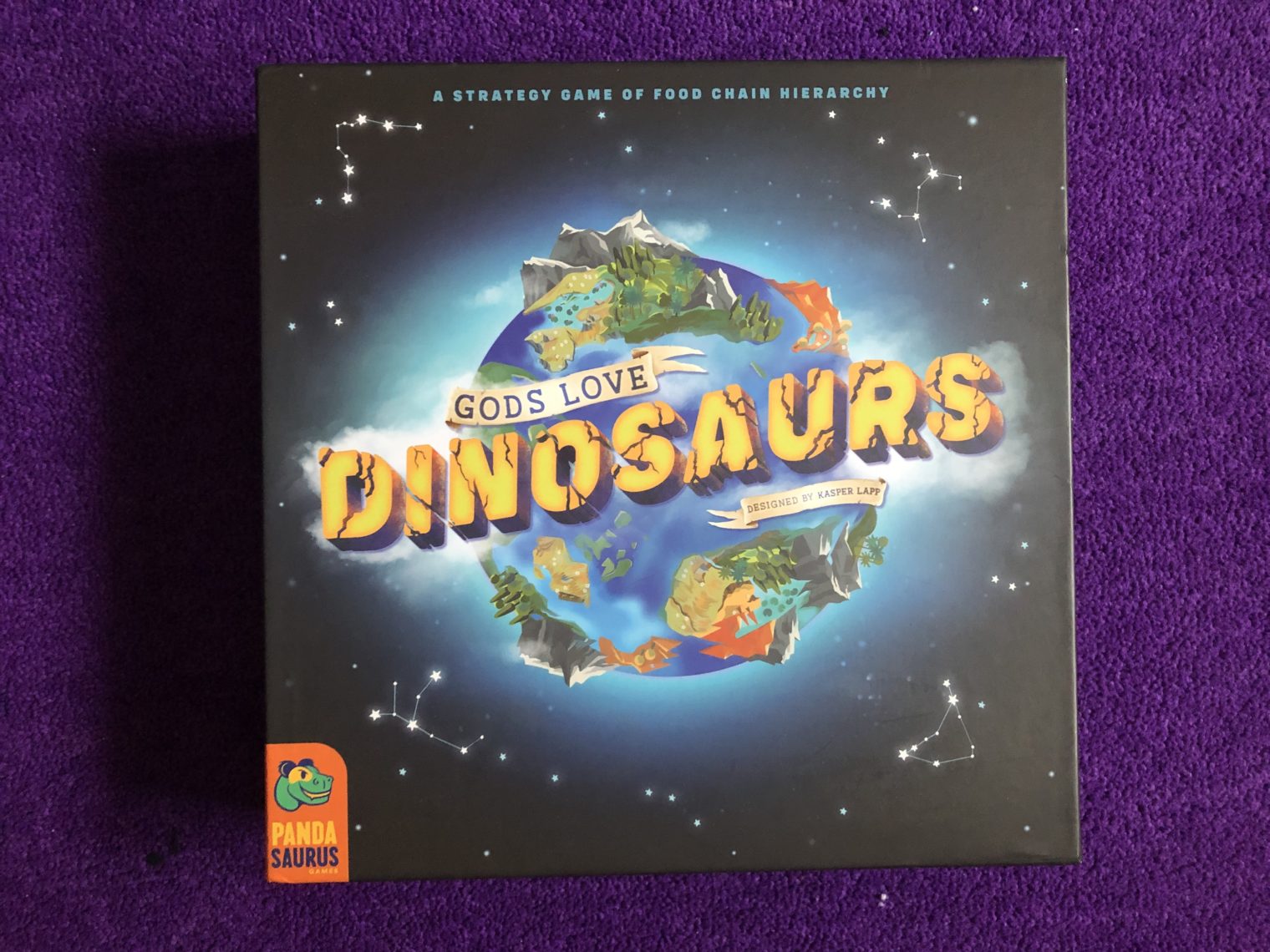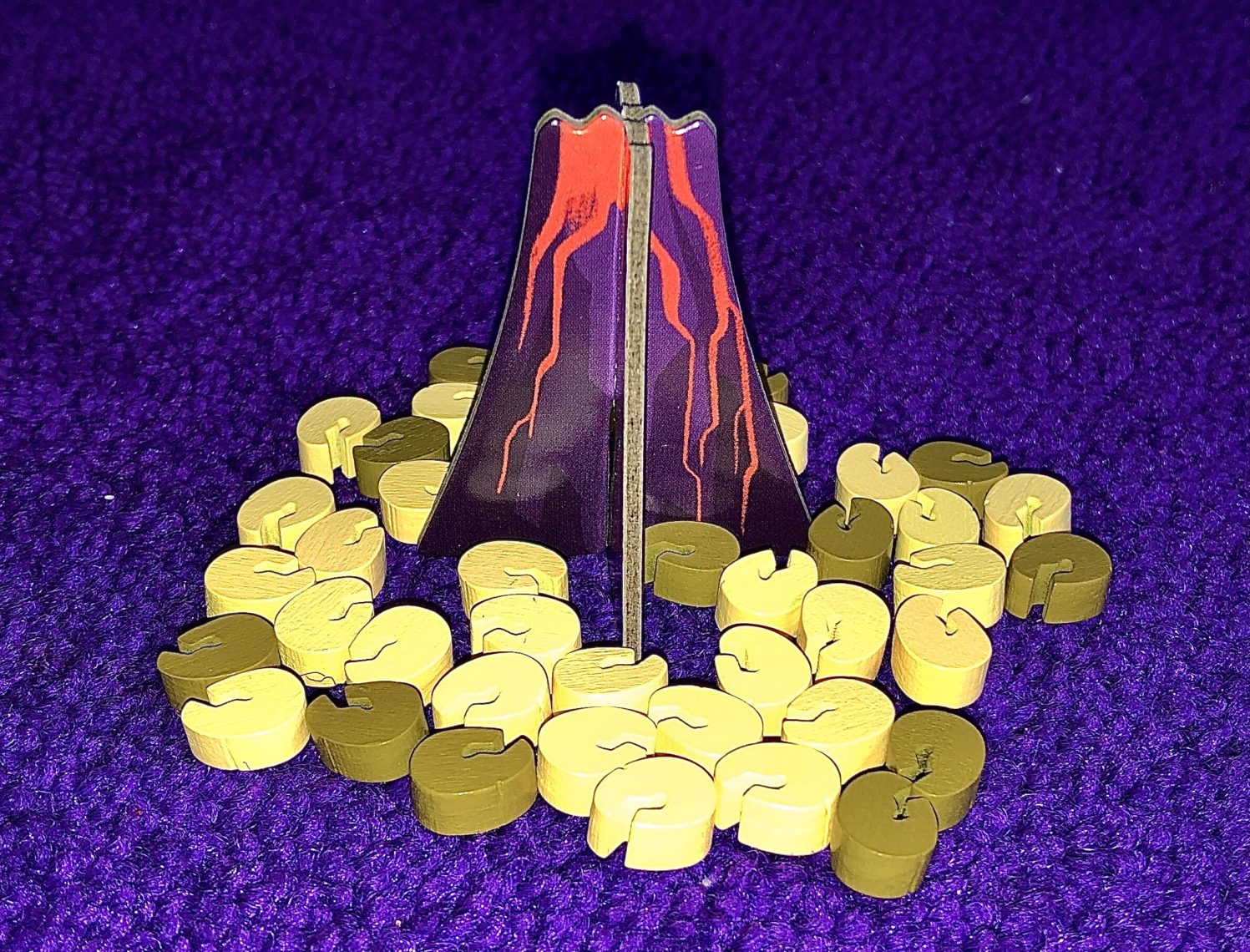The term “God games” usually refers to videogames where the player’s role is that of an omnipotent, omniscient power controlling a population which may or may not be aware of her existence. The first one to consciously explore the trope was 1989’s Populous, but I would argue that SimCity got there around the same time and fits the bill as well. Plus, I remember a mid-80’s title reviewed in GAMES magazine which was about a two-dimensional family you looked in on and took care of…I wish I could remember the title. The genre arguably reached its height with 2006’s Dwarf Fortress which took things to an unbelievably-detailed extreme.
In Modern Tabletop, I would say Spirit Island and Kemet comfortably meet the criteria of a God game, but one could also arguably include games such as Through the Ages, Dominant Species, and Primordial Soup. Not that it matters all that much: I just think that reviewing a game with a name like Gods Love Dinosaurs (GLD hereinafter) kind of begs for some context, amirite?
I mean, on the surface it’s a bit of a weird name for a game. The set of people who believe both in dinosaurs and polytheism is a pretty small one. But I guess that the recent spate of dinosaur-themed games may have left either or both of designer Kasper Lapp or publisher Pandasaurus a bit at a loss for a title. Lapp’s only other major design, 2017’s Magic Maze, was really original and fun, so it was quite a coup for Pandasaurus to sign him up for his next big game. Was it worth it?

GLD is at heart a tile-drafting and resource management game with a food-chain VP engine. The game is split into four “eras” by the tiles–not for any thematic reason, more probably to ensure a relatively stable distribution of terrains and animals throughout the game. There’s a central board where tiles are laid out in batches of 10 or 15 (depending on player count). At the bottom of each column is an icon representing one of the game’s five non-dino species. Each two-hex tile consists of one or two terrain types, one of which might also have an animal icon on it. Each player starts the game with an identical seven-hex “Eden” with a dino nest at the centre surrounded by six hexes, three of which start with the game’s three prey species: froggies, mousies, and bunnies.
Gameplay is very straightforward. You take a tile from the central board and add it to your own personal ecosystem, spawning new prey or predators (tigers, eagles) if the appropriate icon is on it. There’s no restriction on placing new tiles, but there’s plenty of things to think about for optimal placement–mainly potential size of contiguous terrain areas and where you want any new critters to spawn.
If the active player takes the last tile from one of the central board’s columns, the wee beastie pictured at the bottom of the column activates, spawning more copies if it’s prey, and gobbling up prey if it’s a predator. Only predators with access to food survive.
Then, if the activated column also had a dino token on it, everyone’s dinos wake up and activate as well, making babies and hunting. Dinos can eat prey or predators, but they too have to eat or they starve. Every predator they eat generates an egg, which is necessary to spawn as well as providing VP if left over at game’s end. This is the only time that new tiles are dealt out, to fill empty columns. The dino token then moves to the next column and life trundles on. The game ends immediately when a column can’t be filled because the tiles have run out. It’s one point per surviving dino and one point per remaining egg and that’s it.

I’ve read user comments on BGG which accuse GLD of being too simple and deterministic. I suspect that many of these people played the game only once before making their opinions known (shock and horror). I honestly don’t know what they’re talking about. Yes, the ruleset is relatively simplistic–no one is pretending this is a sim–but if you’re playing against anyone of any skill you have quite a few things to keep in mind as you play.
Choosing which tile to place is more than just about the terrains and animals you’ll be adding to your ecosystem. With two or three players especially, when there are only two tiles per column, removing the first tile immediately makes it possible for the next player to activate an animal, and the timing of activations is really important.
Furthermore, while it’s tempting to load up on prey early on and feed them to your dinos, without sufficient prey your predators will die off before the dinos can feed on them. You actually have to achieve a kind of ecological balance between predator and prey in order to pace yourself through the game. This requires keeping a rhythm between predator and prey activations–but what works for you will usually not be optimal for your opponent(s) and vice versa. You have to keep an eye on everyone else’s ecosystems so you can try to predict who will be spawning and who will be hunting and when.
So yes, if you just draw and play, draw and play without thinking, naturally it’s going to feel simplistic and random. But no one ever said BGG comments were accurate. GLD is definitely more than meets the eye.
In fact, the only game I can think of to compare GLD to is Philip Keyaerts’ 2001 game Evo, which is also a God game about competing dino tribes but which uses a completely different set of mechanics (bidding; tech tree; combat) and has a much more in-your-face, competitive vibe. GLD’s player interaction is much more indirect, via the tile drafting and the timing of activations. It’s therefore a much gentler, puzzly game, if that’s what you’re looking for. It’s not as original a design as Magic Maze–but you can’t hit a home run every time you step up to the plate.
Component- and graphic-design-wise GLD is up to Pandasaurus’ usual standard. The different species tokens are cute and distinctive and the artwork on the tiles and in the rules is bright and friendly but not overly cartoonish. I really appreciate the page of Frequently Overlooked Rules on the inside back cover, but I do think the game could have used a rules summary on the back page–at least showing how the different species move and/or eat.
Overall, if you’re not worried about the paleontological/theological issues, and enjoy low-interaction family-friendly games with few rules that scale well and have interesting decisions, Gods Love Dinosaurs is worth checking out.
Thanks to Pandasaurus Games for providing a review copy of Gods Love Dinosaurs for this article.
Comments
No comments yet! Be the first!